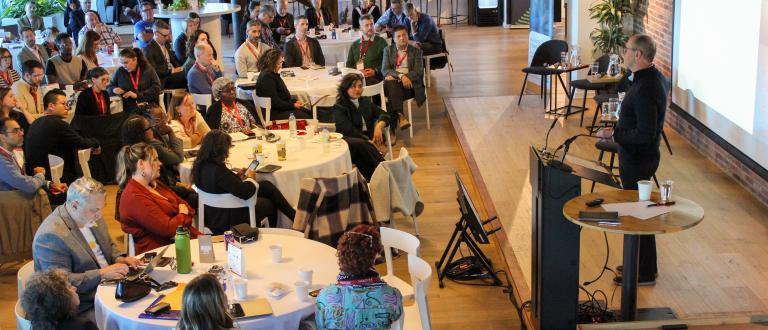This article was originally published by Future of Good and is shared here with permission. It was made possible by HR Intervals, a comprehensive, bilingual free online knowledge base to help nonprofit managers, employees and board members better understand, address, and guide people management within their organizations.
As three quarters of Ontario non-profits faced staff turnover in 2023, more non-profits are implementing novel strategies to recruit and retain their staff.
Statistics showing 93 percent of Canadians are interested in four-day workweeks have prompted employers to listen.
While only 8 percent of Ontario non-profits have implemented a four-day workweek so far, those who have are seeing excellent results.
Imagine Canada, an organization supporting Canadian charities and non-profits, has been a staunch supporter of the shorter-week model.
“It can feel like quite a dramatic change to bring about for an organization,” said Haley MacDonald, Director of Experience and Change at Imagine Canada, who helped the organization prepare for and implement its four-day workweek pilot.
“But the benefits, in terms of staff feeling cared for and having more resources at their disposal, just through the gift of a bit more time, can have monumental benefits to your organization.”
Proponents say four-day workweeks are good for employers and employees alike, boosting employment levels and staff retention while increasing performance and motivation. Supporters also say the short week is beneficial to staff health and wellbeing while cutting down on costs from sick days, allowing employees to do things like schedule doctor appointments in their off time and return to work after a three-day weekend re-energized.
While there are some challenges to overcome, such as rearranging long-standing schedules and maintaining a comprehensive list of services in a shorter week, organizations are making this change to benefit their staff without losing their ability to deliver critical services to their communities.
Since Imagine Canada launched the four-day workweek pilot in January 2023, they have noted a 66 percent increase in the mental, physical and emotional health of their staff, as well as a massive increase in satisfaction related to work-life balance, shown in frequent polling. They say sick days have been reduced by 40 per cent, and their staff retention rate is 94 per cent as of the end of 2024.
Productivity also remains stable, decreasing in a few areas but increasing in others. For example, the number of policy briefs, op-eds, and other outreach to advance policy campaigns has increased 86 per cent. Membership has increased by 20 percent, too.
While MacDonald said staff and leadership alike have responded to the four-day workweek with “resounding optimism and support,” the flipside is that a critical mass of work still must be completed.
At first, MacDonald said, a major funder even expressed some skepticism, but extensive discussions ultimately reassured stakeholders that a four-day workweek would not diminish the service they had come to expect.
In fact, Imagine Canada has added even more services to their roster since converting to a shortened workweek.
“Monday to Thursdays now are very intense. I hear from a lot of folks that there's still a lot of work being fit into those four days,” said Macdonald. “I think the good news is that hard work and that intensity is really offset by that fifth day off where folks are really arriving on a Monday morning feeling much more refreshed.”
Tim Richardson, a senior manager at Imagine Canada, was one of the early champions of the four-day workweek. Despite the intensity of the new Monday-to-Thursday schedule, the Fridays off empower him to take the time he needs to balance things like child care, hobbies, and chores.
“It's life-giving,” Richardson said. “I definitely feel more present and driven at work.”
However, in order to take this time off without compromising productivity, some things had to be removed from the agenda. Richardson said Imagine Canada had to cut down on excess meetings, which is not necessarily negative.
Indeed, a recent survey from Harvard Business Review showed 71 percent of managers say many meetings are unproductive and inefficient, and 64 percent said meetings cut into deep thinking.
“Meeting reduction was a big thing, and being more intentional about when a meeting is appropriate,” Richardson said, explaining many weekly meetings became bi-weekly, for example, when the week was shortened.
Imagine Canada also instituted meeting-free Mondays and Fridays leading up to the four-day workweek trial to help prepare.
Now, Richardson said he receives numerous calls from organizations hoping to implement four-day workweeks for their own company.
Apart from rethinking meetings, which Richardson said is a “really good way to prepare,” he recommended a solid trial period to determine how well it could work for a given organization.
“Make the pilot long enough and over a period that is representative of what your organization does,” Richardson said, adding it should be long enough to test the busy periods and the ebbs and flows of various seasons.
“A three month pilot is way too short …you're going to have all the adaptation and growing pains with none of the benefits.”
But, it’s not a one-size-fits-all solution, and implementing a four-day workweek may look different for organizations depending on their mandate.
For this reason, Silent Voice Canada, a charity serving the Deaf community with direct, week-round programming, had to think a bit differently when implementing a shorter workweek to partake, opting for a 32-hour week.
Here, the staff have a choice of spreading those hours over five or six days, depending on their workload, or taking longer days over four days.
“I wanted to be part of the real cultural shift of how we manage our work,” said Kelly Mackenzie, executive director of Silent Voice Canada, despite the fact that Silent Voice offers programming for their clients six days a week.
As a result, a 32-hour week allows varying, staggered schedules to keep the services running.
“We do have the luxury of having enough staff that our client services was not impacted at all,” Mackenzie said, adding the flexible schedule has helped not only with staff retention but also attraction.
“More than 90 per cent of the staff of Silent Voice are deaf themselves. We have deaf community members coming up to us, saying, ‘When do you have a job vacancy? I want to work for Silent Voice,’” Mackenzie said.
And, while this is a fairly new practice for some non-profits, others have been operating under a four-day workweek for decades.
When it was founded in 1990, the David Suzuki Foundation implemented a four-day, 34-hour workweek. The foundation maintains that this can also help it work toward its mandate and be beneficial for the environment.
Their argument is that reduced work hours, flexible schedules, and telecommuting can also cut pollution and greenhouse gas emissions.
“It's associated to a direct reduction in the carbon footprint of an organization,” said Sabaa Khan, Québec and Atlantic Canada Director-General for the David Suzuki Foundation.
While Khan said more studies need to be done in Canada, a study in the United Kingdom showed that a widespread four-day workweek could reduce the country’s annual carbon footprint by 21.3 percent. When dealing with problems as large and overarching as climate change, for example, Khan said it’s important for organizations to protect their staff from overwork, burnout, and pervasive climate anxiety.
“When you're working in an area that's mission driven – climate change, biodiversity protection – you're looking at massive existential problems on a daily basis … There's prevalent climate anxiety amongst people who work in the field,” Khan said, adding that how long you can stay in the social good sector depends on how well you can strike a work-life balance.
“The four-day workweek, from this perspective, it can draw employees but also ensure that employees are staying longer,” Khan said.
This article was originally published on Future of Good.



